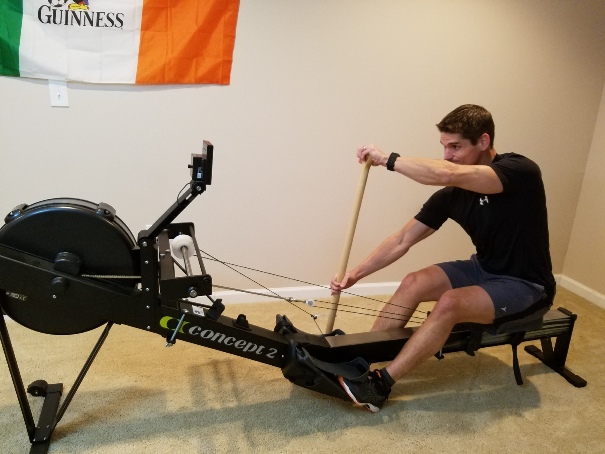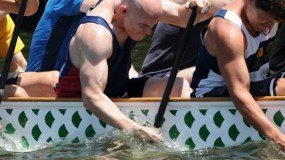INDOOR PADDLING
By Leo Young, B.App.Sci. (Sport Sci.), B.Bus., Grad.Dip. Clin. Nutr., C.S.C.S.
Indoor paddling is a relatively new phenomenon to canoeing, having evolved from the rapidly growing and highly developed sport of indoor rowing. The World Indoor Rowing Championships attracts thousands of elite athletes and have been contested for over ten years now. The annual World Ranking’s feature almost 30,000 entries from over 60 countries and the competition calender now includes over 100 major indoor championships.
The Concept II Rowing Ergometer, first developed in 1981, is the machine used is both indoor rowing and paddling and is used exclusively by Olympic Rowing teams worldwide as an integral part of their training, testing and crew selection programs.
Paddling Adaptor
By utilising the Vermont Waterways Paddling Adaptor in conjunction with the Concept II Rowing Ergometer you are able to effectively simulate single blade paddling. Once the adaptor is initially installed, it takes less than a minute to switch from rowing to paddling and vice versa.
The Paddling Adaptor has been cleverly designed to effectively simulate the biomechanics of on water canoe paddling. The best results are achieved by keeping the paddle shaft as perpendicular as possible to the main drive cord (and the drive cord as parallel to the ground as possible) in the same way as one attempts to keep the paddle perpendicular to the water when canoeing. Any concern about the possibility of “cheating” on the ergometer, by taking longer strokes than are possible on the water, are unfounded, as taking excessively long strokes will only result in a lower score.
Performance Monitor
The Concept II ergometer features a highly accurate performance monitor which allows for the direct comparison of times and distances under drastically different environmental conditions. The monitor recalibrates itself every stroke and is able to detect and immediately correct for any changes in air flow and air density occurring due to factors such as changes in vent settings, barometric pressure, altitude, ambient temperature, humidity, wind conditions and proximity of external objects.
The Performance Monitor also produces scores which reflect the cubed relationships that exits within fluid dynamics between power output and speed (ie. Δ speed = 3 √ Δ power ) in the same manner as that which occurs when moving a craft on water (eg. doubling speed requires an eightfold increase in power output, or alternatively, increasing speed by 10% would require a 33% increase in power).
The Effect of Bodyweight and Craft Weight on Paddling Performance.
One very important factor that the ergometer does not direct take into account is the bodyweight of the user and the effect this would normally have on boat speed in the water. Larger athletes, obviously, have an advantage on the ergometer, as their greater bodyweight should generally provide them with the potential to produce higher power outputs (both aerobically and anaerobically). When racing in a craft on water, however, this power advantage is largely negated by the effect of their bodyweight on craft drag.
Canoe drag is proportional to the wetted surface area of the craft and this is proportional (all other things being equal) to total weight (canoe plus paddler weight) expressed to the power of two-thirds. What this means is that canoe drag increases by a proportionately smaller degree than increases in canoe or paddler weight (eg. doubling the weight of the canoe and paddler results in only a 58.7% increase in canoe drag: 2^(2/3) = 1.587).
Interestingly, aerobic capacity is not, as commonly believed, directly proportional to bodyweight, but rather is proportional to body surface area factors (eg. surface area of aveoli, red blood cells, capillary walls, mitochrondia etc) which equates to bodyweight expressed to the power of two – thirds. Therefore, all other things being equal, larger athletes have higher aerobic capacities in absolute terms (L/min), smaller athletes have higher aerobic capacities relative to their bodyweight (ml/kg/min), but athletes of varying sizes have potentially equal aerobic capacities, when it is expressed neutrally, relative to body surface area or bodyweight to the power of two-thirds.
What this means is that in endurance races (ie. races of more than ten minutes duration), where aerobic capacity is the limiting factor, the physiological advantage of greater bodyweight is largely neutralised by the effect of bodyweight on canoe drag. The larger athlete still has some advantage though, because the weight of the canoe (or share of canoe weight in a crew boat) constitutes a relatively smaller proportion of their bodyweight (eg. 15kg OCI represents 15% additional weight for a 100kg athlete as opposed to 20% additional weight for a 75kg athlete, which represents a little less than a one percent time advantage to the 100kg athlete:3√ [(1.20 / 1.15) ^(2/3)] =1.0095).
In sprint races (ie. races of less than one minute) where anaerobic capacity is the limiting factor, the advantage to the larger athlete is more pronounced. This occurs because potential anaerobic power is directly proportioned to bodyweight (all other things being equal). Therefore a 100kg paddler can potentially produce 33.3% more anaerobic power than a 75kg athlete (100/75 = 1.333) but incurs say only 17.8% more drag in a 15kg OCI ([115/90] ^(2/3) = 1.178) which gives the larger athlete a 4.2% time advantage (3√ 1.333/1.178 = 1.042).
In crew boats larger athletes tend to have a more distinct advantage because the share of bodyweight that each paddler must “carry” constitutes a heavier weight than in one man boats and furthermore, depending on race conditions, the steerer may have to be “carried” by the other paddlers. For example if one assumes the “all up weight” of an OC6 to be say 200kg and the steerer to be say 75kg, then you have a situation where you might have five paddlers sharing 275kg of additional weight (ie. 55kg ea). For a 100kg paddler this constitutes 55% of their bodyweight, whilst for 75kg paddler this represents 73.3%. This gives a crew of 100kg paddlers a potential time advantage of 2.5% in an endurance race and 5.8% advantage in a sprint race.
Accounting for Bodyweight on the Ergometer
The Concept II Rowing Ergometer and Paddling Adaptor are invaluable tools for training, testing paddling specific fitness parameters, monitoring fitness improvements and crew selection. However, the effect of bodyweight must be accounted for, when using test scores for crew selection purposes.
Currently world record ranking’s on the Paddling Adaptor exist for 1000m and 30minutes. These distances represent excellent representative test pieces for testing and crew selection purposes for sprint and marathon races respectively.
Paddlesport Training Systems Note: If you would like us to email you Leo Young’s formulae for weight correction, just let us know.

